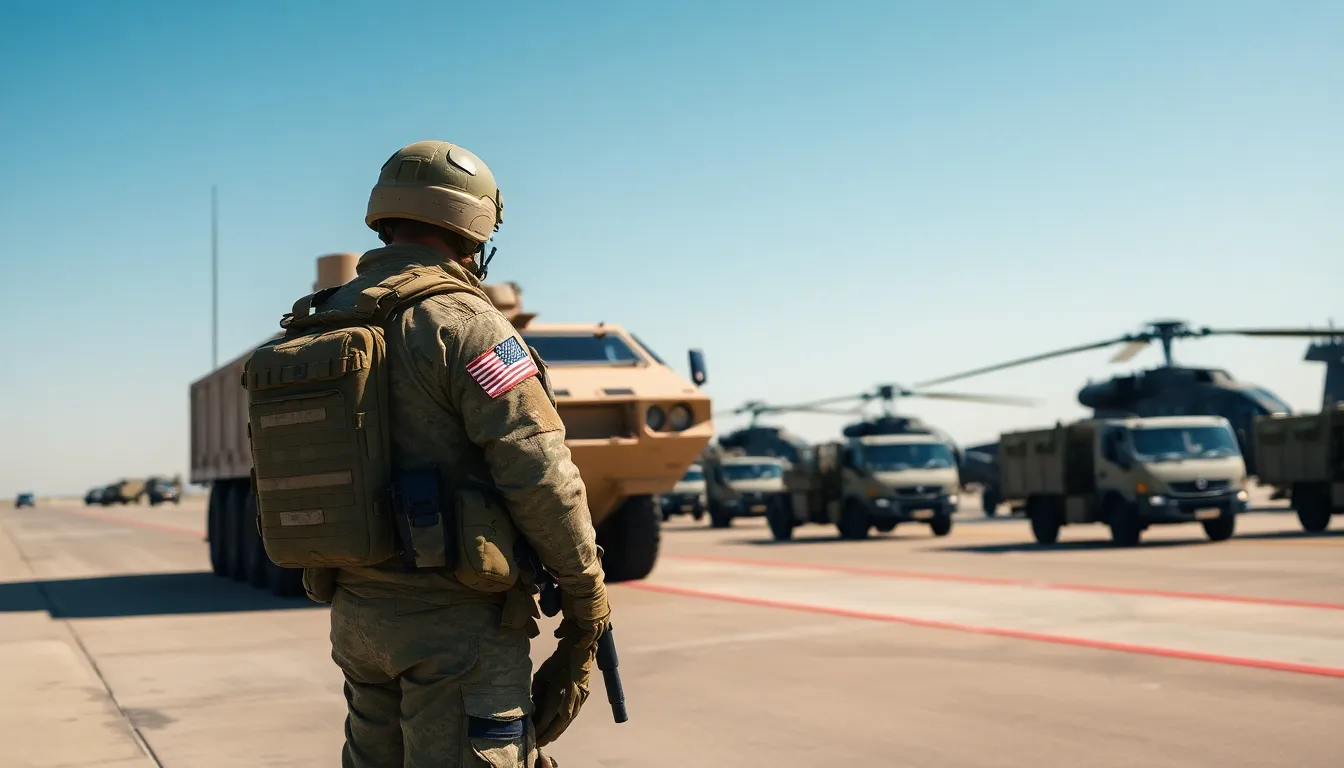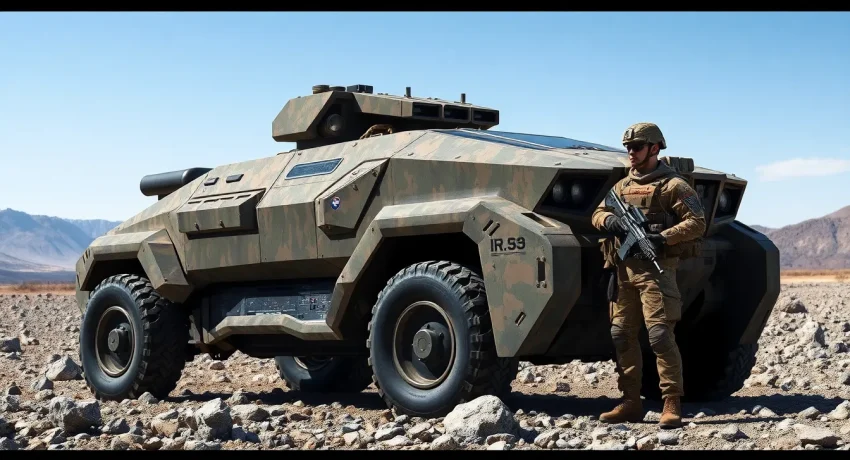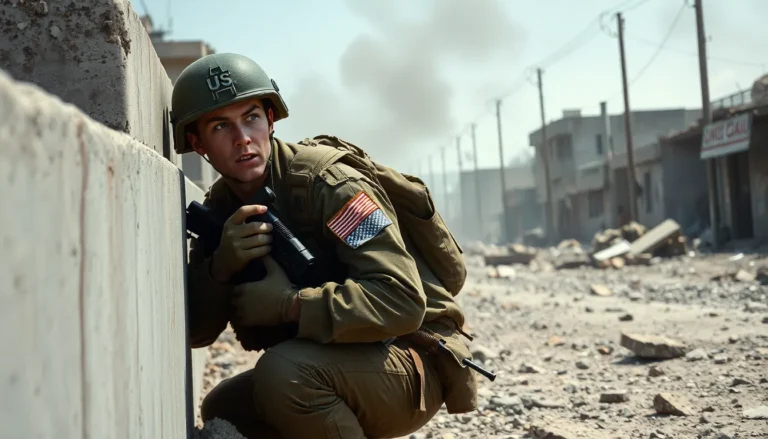In the chaotic world of warfare, getting troops and supplies from point A to point B can feel like herding cats—if those cats were armed and had a penchant for explosions. Battlefield transport isn’t just about moving gear; it’s a high-stakes game of strategy, speed, and sometimes, sheer luck. From armored vehicles to helicopters, the right transport can mean the difference between victory and a very awkward retreat.
Imagine a battlefield where soldiers zip around in style, riding in vehicles equipped with the latest tech, all while dodging enemy fire and questionable decisions. It’s not just about getting from one location to another; it’s about doing it with flair and efficiency. As military operations evolve, so do the methods of transport, blending innovation with a touch of humor—because who said war can’t have a little fun? Buckle up as we explore the fascinating world of battlefield transport.
Table of Contents
ToggleOverview of Battlefield Transport
Battlefield transport encompasses the movement of troops, supplies, and equipment during military operations. This strategic process directly influences mission success and operational efficiency. Vehicles employed in transport vary significantly, including wheeled trucks, armored vehicles, and aircraft. Each type plays a crucial role based on the terrain, enemy presence, and mission objectives.
Evolution in transport methods has shaped modern warfare. Enhanced capabilities of vehicles equipped with advanced navigation systems, communication tools, and protective features allow for swift maneuvering in conflict zones. As conflicts become more complex, transport strategies also adapt. Automation and robotics are increasingly utilized to assist with logistics, reducing human risk and optimizing efficiency.
Additionally, challenges persist in battlefield transport. Weather conditions, rough terrain, and enemy interference frequently disrupt supply lines. Coordinating transport under such circumstances demands meticulous planning and real-time decision-making. Military planners emphasize logistics as a vital element of strategy, recognizing that delays can jeopardize entire missions.
Real-time data tracking has transformed how military forces manage transports. GPS technology and satellite communications facilitate precise coordination, ensuring timely deliveries of essential supplies. Each advancement in transport technology not only improves operational capacity but also enhances the safety of personnel involved.
Overall, battlefield transport remains a cornerstone of military strategy. Continuous innovations and adaptations to emerging challenges define how armed forces approach logistics on the battlefield. Maintaining effectiveness in transport operations reinforces the broader objectives of military campaigns, establishing a clear link between logistics and success in combat scenarios.
Types of Battlefield Transport

Battlefield transport encompasses various vehicle types designed for different operational needs in military logistics. Each category plays a crucial role in ensuring mission success and the efficient movement of troops, supplies, and equipment.
Ground Transport Vehicles
Ground transport vehicles include wheeled trucks, armored personnel carriers, and logistics vehicles. Wheeled trucks excel in transporting cargo across diverse terrain while ensuring quick logistics support. Armored personnel carriers provide vital protection for troops as they move into combat zones. Multimodal transport options often include trailers and flatbeds, enabling flexible configurations for various mission requirements. Mobile command vehicles also facilitate real-time decision-making and communication in the field.
Aerial Transport Options
Aerial transport options primarily consist of helicopters and cargo planes. Helicopters enable rapid troop deployment into inaccessible areas, enhancing operational responsiveness. Cargo planes efficiently deliver larger quantities of supplies, often operating from remote airstrips. Drones further revolutionize logistics by supplying real-time reconnaissance and resupply missions. Each of these aerial vehicles supports various missions by allowing rapid movement and logistical support, crucial in modern warfare.
Naval Transport Services
Naval transport services include amphibious assault ships and supply vessels. Amphibious assault ships facilitate direct landings of troops and equipment on shorelines, providing versatility in coastal operations. Supply vessels ensure the delivery of essential resources, such as food, ammunition, and medical supplies, across oceans. Additionally, naval transport often includes support for logistics operations and evacuation capabilities. Integrating these naval services into military strategies fosters a comprehensive approach to battlefield logistics, directly impacting mission effectiveness.
Importance of Battlefield Transport
Battlefield transport plays a critical role in military operations, directly impacting the effectiveness of missions. Efficient movement of troops and supplies can determine the outcome of engagements.
Strategic Advantages
Transport strategies afford numerous benefits in combat scenarios. Quick troop deployment enhances response times and aids in gaining a tactical edge. Vehicles designed for specific terrains, like all-terrain trucks, allow forces to navigate challenging environments effectively. Armored personnel carriers offer protection while moving soldiers directly into combat zones. Aerial transport, such as helicopters, facilitates rapid medical evacuations and reinforcements, ensuring soldiers receive crucial support when needed. Each transport method contributes uniquely to operational success, allowing commanders to utilize resources strategically.
Logistics and Supply Chain Management
Logistics remains a cornerstone of military effectiveness. Ensuring timely resupply of essential goods, like ammunition and fuel, keeps operations moving smoothly. Coordination among different branches of the military enhances efficiency, as trucks distribute supplies while aircraft handle long-distance deliveries. Real-time tracking technology aids in managing inventory accurately, preventing shortages during critical missions. Supply chain management not only involves transportation but also encompasses planning and resource allocation. Successful logistics ensure that combat units remain equipped and ready for action, directly influencing mission outcomes.
Innovations in Battlefield Transport
Innovations are reshaping battlefield transport, enhancing efficiency and tactical capabilities. Military forces increasingly rely on cutting-edge technologies to streamline logistics.
Emerging Technologies
Artificial intelligence optimizes route planning, minimizing travel time and enhancing troop safety. Autonomous vehicles revolutionize logistics, allowing for the transport of supplies without putting service members at risk. Smart sensors track vehicles in real time, improving inventory management and enabling immediate resupply. Additionally, drone technology facilitates rapid delivery of essential goods, adapting to dynamic battlefield conditions. Their use for reconnaissance also expands situational awareness. 3D printing emerges as a game-changer, enabling on-site production of spare parts, which reduces dependence on lengthy supply chains.
Future Trends
Sustainability in transport is becoming a priority, with electric vehicles gaining traction in military logistics. Advances in battery technology promise longer operational durations, allowing vehicles to operate in remote areas without extensive refueling. Integration of augmented reality ensures enhanced situational understanding, aiding operators in complex environments. Moreover, collaborative networks utilizing blockchain improve transparency in supply chain operations, fostering trust among military branches. The shift toward hybrid systems combines conventional and modern methodologies, aiming to create versatile solutions that respond effectively to evolving battlefield needs.
Challenges in Battlefield Transport
Battlefield transport faces significant challenges that hinder the efficiency and effectiveness of military operations. Various factors complicate logistics and decision-making processes in high-stress environments.
Terrain and Environmental Factors
Navigating diverse terrains poses substantial difficulties. Rough landscapes such as mountains, forests, and deserts require specialized vehicles for safe and effective passage. Inclement weather adds another layer of complexity, as rain, snow, and extreme temperatures affect vehicle performance and troop mobility. Adverse conditions can lead to delays, ensuring that precise planning is critical for success. For example, historical campaigns demonstrate that poor weather can immobilize units, impacting mission outcomes. Adapting transport strategies to accommodate environmental factors is essential.
Security Threats
Security threats remain a constant concern during battlefield transport. Enemy forces may actively seek to disrupt supply lines or target transport vehicles. The risk of ambushes or IEDs can significantly compromise troop safety. Maintaining situational awareness through reconnaissance and intelligence gathering helps mitigate these risks. Countermeasures such as armored vehicles improve protection against hostile actions. Coordination with intelligence units enhances operational security, ensuring that transport routes remain secure. The presence of potential threats underscores the necessity for rapid response strategies in the event of an attack.
Battlefield transport is an indispensable element of military operations. Its effectiveness can significantly influence mission outcomes and operational success. As technology continues to evolve, the integration of advanced systems and innovative strategies enhances logistics capabilities.
The challenges faced in this domain require constant adaptation and strategic planning. By leveraging real-time data and cutting-edge vehicles, armed forces can navigate complex environments more efficiently. The future of battlefield transport looks promising with a focus on sustainability and automation, ensuring that military logistics remain agile and responsive. Ultimately, the ongoing advancements in this field will continue to shape the landscape of modern warfare.




